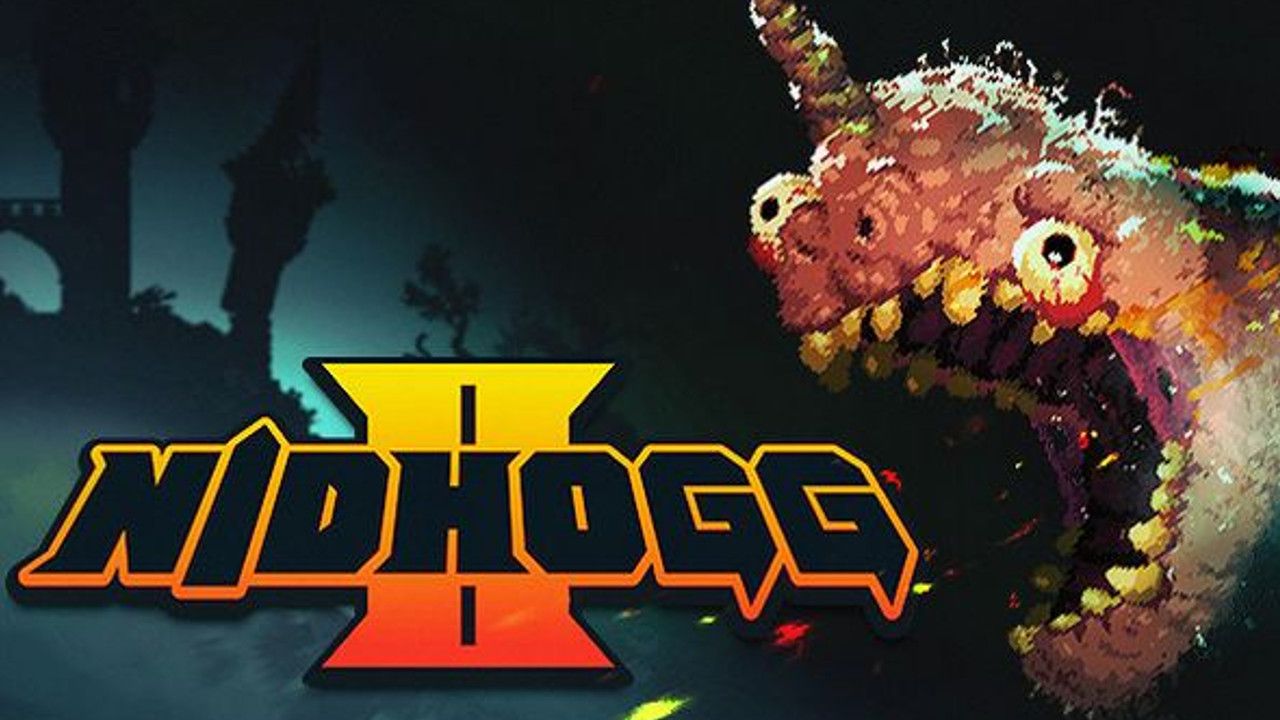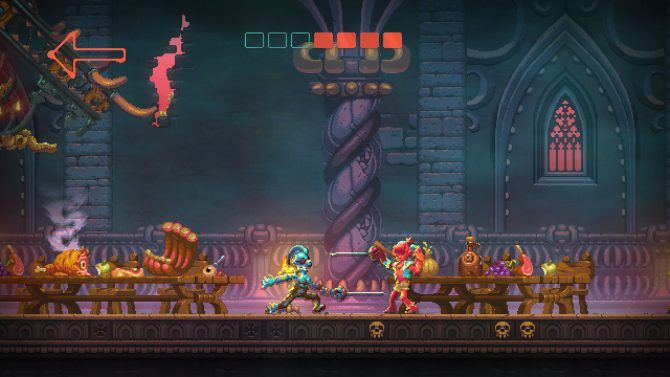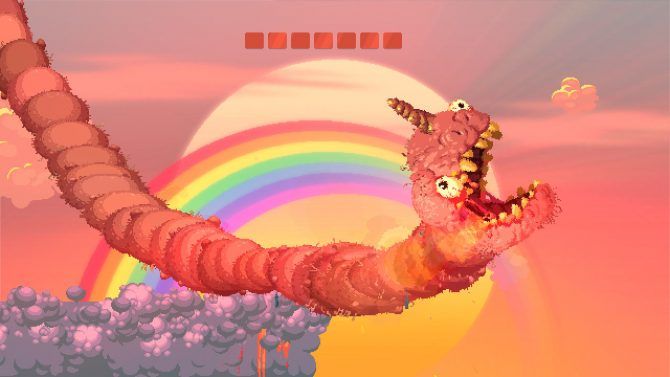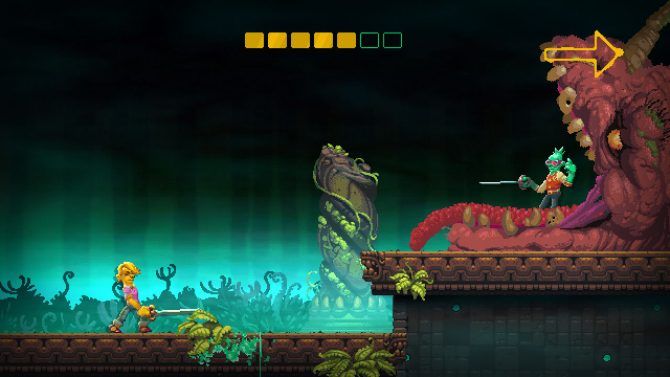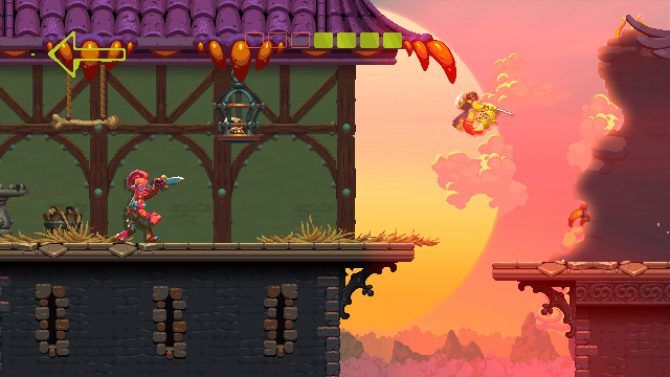Kill or be killed. It's a phrase that has been overused for years to depict any action-packed experience where murder plays a role. However, this trite motto truly exemplifies Messhof Games' beloved fighting game, Nidhogg. I remember the game garnering an incredible amount of praise when the it released back in 2014, and rightfully so. It was the best competitive multiplayer game to launch that year with its unique mixture of fast-paced strategic combat and retro-styled visuals. For such a rudimentary game to be recognized as such was a feat for the small indie developer.
Fast forward another three years, the sequel, Nidhogg 2, is released to the masses featuring the same simple premise the original was known for: fight your way to the end of the stage, and get devoured by the titular mythological Norse serpent, Nidhogg. While the game features the same admirable sidescrolling tug-of-war combat from the original, a few departures from the initial release make this iteration a whole different experience.
[pullquote]"While the game features the same admirable sidescrolling tug-of-war combat from the original, a few departures from the initial release make this iteration a whole different experience"[/pullquote]
Nidhogg 2 is a game of attrition. Each time you or your opponent win a bout, the victor may advance further into the stage; in turn, the loser now has a longer trek to reach the mythological drake. These victories are decided by engaging in armed or unarmed combat. However, unlike the original, Nidhogg 2 includes four weapons available to use: rapier, broadsword, dagger, and bow.
The rapier makes its return to Messhof Games' sequel, with the same mechanics from the previous release. Players will take three stances — low, mid, and high — in order to counter their opponent's attack. Blocking with the rapier requires the defender to assume the same stance. It is, by far, the most versatile and favorable weapon out of the available armaments.
A big counter for the rapier is the broadsword. Players are able to assume a low and high stance, leaving them vulnerable to the mid stance. The hulking weapon is great in a defensive capacity. Knocking weapons out of your opponents hands can be done effortlessly. However, players must assume a low or high stance, leaving them vulnerable to the rapier's mid stance. It also exhibits a slow attack speed that does not allow for a quicker strategy like the rapier or the agile dagger.
The dagger can be an incredibly resourceful weapon if used correctly. While it has a short range with minimal defensive abilities, its speed allows for fast kills up close and from afar. The only weapon that gave me a hard time while holding the agile weapon was the rapier. Since the rapier has more reach and a favorable attack speed, more often than not, I would lose against the versatile weapon. Regardless, I found the dagger incredibly useful as a throwing weapon by pitching it at my opponent as they spawned.
The actual ranged weapon — the bow and arrow — is surely the worst weapon in the game. The weapon does have its advantages, but its benefits are situational. Using the bow does allow you give yourself and your opponent some space; it can also slow the pace of the match. However, the arrows can be easily dodged and countered, especially if your opponent has a rapier. The three stances of the resourceful weapon can be used to deflect the arrows back at the archer typically ending in their death. Spawning with the bow was usually followed by a guttural sigh of disapproval, as I knew my defeat was imminent.
Weapons were not the only element that dictated the tides of battle. Each stage was designed to create pockets where the loser can get some leverage. Many times, these advantageous sections were created with the use of doorways or a platform's positioning. The clever stage design creates a fair playing field. If Messhof Games made each environment completely flat, a highly skilled player would always reign superior. With each stage containing these favorable positions, both expert and beginner players have an opportunity to be victorious.
[pullquote]"The best way I can describe Nidhogg 2's visuals is grimy. I mean that in the most positive way possible." [/pullquote]
The cleverly designed environments are coated in some of the most outlandish illustrations I have seen in a game. The best way I can describe Nidhogg 2's visuals is grimy. I mean that in the most positive way possible. The colorful palette is absurdly vibrant, but is paired with goofy combatants within dingy arenas, some filled with grossly mutated creatures. The dichotomy between the bright colors and the repulsively designed creatures gives some life to the game's seemingly interesting world.
Every facet of Nidhogg 2 is great. The various weapons allow for complex gameplay. The cleverly designed stages allow for players to implement different strategies each match. Even the grimy visuals bring some sort of allure to the game's odd world. Nevertheless, one small issue hinders Nidhogg 2 from being the ultimate multiplayer game: the online mode.
Playing online is the same as the local multiplayer mode, but you can play with people from around the world. That sounds amazing, right? Who would not want to play this fun fighter online? Unfortunately, I am one of those people.
My positivity toward Nidhogg 2 was suddenly impeded by my online experience. The game requires enough precision for any input lag to be infuriating. Your strategy's success is intrinsic on how you react to your opponent's next move. When you jump to clear an opening only to find yourself falling to your death because of a faulty connection was simply aggravating, and put a soured my time with the online portion of the game. Sure, there is a single player arcade mode that allows me to play by myself, but the joy of defeating an actual person is lost.
Fortunately, the local multiplayer mode made the hindrance of the online mode unnoticed. As I played a couple rounds with some friends, we found ourselves laughing at each other's disbelief when one of us disarmed our opponent and stomped their face to a bloody pulp. Each match led to some hilarious banter as we jumped, climbed, and attacked each other to victory. This is where Nidhogg 2 shines. Its strategic gameplay was meant to be played with two players sitting side-by side, interacting with one another, and ultimately disgracing your opponent by showboating in front of their face.
[pullquote]"Nidhogg 2 is an exemplary symbol of how to create a gratifying multiplayer game."[/pullquote]
Nidhogg 2 is an exemplary symbol of how to create a gratifying multiplayer game. It builds on the simplicity of the original while maintaining an identity of its own. This simplicity alongside its uniquely grimy visuals creates an inviting experience that anybody can jump right in and enjoy. The additional weapons and cleverly designed stages add an extra layer of strategy, giving it enough complexity to appease those who want it, but still rudimentary enough for players who want a straightforward experience.
However, my overwhelming positivity was extinguished when entering an online match. Connection stability is the true enemy, resulting in some unfavorable circumstances not of my own accord. If you have a few friends looking for a fun game to play, Nidhogg 2 is the perfect choice. If you're looking to jump online, I would advise against it.

